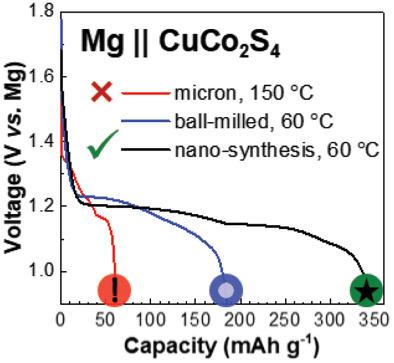当前位置:
X-MOL 学术
›
Small Methods
›
论文详情
Our official English website, www.x-mol.net, welcomes your feedback! (Note: you will need to create a separate account there.)
Direct Nano‐Synthesis Methods Notably Benefit Mg‐Battery Cathode Performance
Small Methods ( IF 12.4 ) Pub Date : 2020-02-25 , DOI: 10.1002/smtd.202000029 Lauren E. Blanc 1 , Xiaoqi Sun 1 , Abhinandan Shyamsunder 1 , Victor Duffort 1 , Linda F. Nazar 1
Small Methods ( IF 12.4 ) Pub Date : 2020-02-25 , DOI: 10.1002/smtd.202000029 Lauren E. Blanc 1 , Xiaoqi Sun 1 , Abhinandan Shyamsunder 1 , Victor Duffort 1 , Linda F. Nazar 1
Affiliation

|
Rechargeable magnesium batteries are promising candidates for next‐generation electrochemical energy storage, but their development is severely hindered by sluggish solid‐state diffusion and significant desolvation penalties of the divalent cation. Studies suggest that nano‐sized electrode materials alleviate these issues by shortening diffusion lengths and increasing electrode/electrolyte interaction. Here, the effect of particle size and synthetic methodology on the electrochemical performance of four sulfide cathode materials in Mg batteries is investigated: layered TiS2, CuS, spinel Ti2S4, and CuCo2S4. In these sulfide hosts, the direct preparation of nano‐dimensional crystallites is critical to activate or improve electrochemistry. Even promising cathode materials can appear electrochemically inert when micron‐sized particles are investigated (e.g., CuCo2S4), and mechanical milling leads to surface degradation of active material which severely limits performance. However, nano‐sized CuCo2S4 prepared directly reaches a capacity nearly double that of ball‐milled material and delivers 350 mAh g−1 at 60 °C. This work provides synthetic considerations which may be crucial in the discovery and design of novel Mg cathode materials, so that promising candidates are not overlooked. By extension, in oxide materials where Mg2+ diffusion is expected to be much more sluggish, this factor is anticipated to be even more important when screening for new hosts.
中文翻译:

直接纳米合成方法显着提高镁电池阴极性能
可充电镁电池是下一代电化学能量存储的有前途的候选者,但其发展因固态扩散缓慢和二价阳离子的严重去溶剂化作用而受到严重阻碍。研究表明,纳米级电极材料可通过缩短扩散长度和增加电极/电解质相互作用来缓解这些问题。在此,研究了粒度和合成方法对镁电池中四种硫化物正极材料的电化学性能的影响:层状TiS 2,CuS,尖晶石Ti 2 S 4和CuCo 2 S 4。在这些硫化物主体中,直接制备纳米微晶对于激活或改善电化学至关重要。当研究微米级颗粒(例如CuCo 2 S 4)时,甚至很有希望的阴极材料也可能在电化学上表现出惰性,并且机械研磨会导致活性材料的表面降解,从而严重限制性能。但是,直接制备的纳米级CuCo 2 S 4的容量几乎是球磨材料的两倍,可提供350 mAh g -1在60°C。这项工作提供了综合的考虑因素,这对发现和设计新型的Mg阴极材料可能至关重要,因此不会忽略有前途的候选材料。通过扩展,在预期Mg 2+扩散会更加缓慢的氧化物材料中,当筛选新的基质时,预计该因素将变得更加重要。
更新日期:2020-02-25
中文翻译:

直接纳米合成方法显着提高镁电池阴极性能
可充电镁电池是下一代电化学能量存储的有前途的候选者,但其发展因固态扩散缓慢和二价阳离子的严重去溶剂化作用而受到严重阻碍。研究表明,纳米级电极材料可通过缩短扩散长度和增加电极/电解质相互作用来缓解这些问题。在此,研究了粒度和合成方法对镁电池中四种硫化物正极材料的电化学性能的影响:层状TiS 2,CuS,尖晶石Ti 2 S 4和CuCo 2 S 4。在这些硫化物主体中,直接制备纳米微晶对于激活或改善电化学至关重要。当研究微米级颗粒(例如CuCo 2 S 4)时,甚至很有希望的阴极材料也可能在电化学上表现出惰性,并且机械研磨会导致活性材料的表面降解,从而严重限制性能。但是,直接制备的纳米级CuCo 2 S 4的容量几乎是球磨材料的两倍,可提供350 mAh g -1在60°C。这项工作提供了综合的考虑因素,这对发现和设计新型的Mg阴极材料可能至关重要,因此不会忽略有前途的候选材料。通过扩展,在预期Mg 2+扩散会更加缓慢的氧化物材料中,当筛选新的基质时,预计该因素将变得更加重要。



























 京公网安备 11010802027423号
京公网安备 11010802027423号